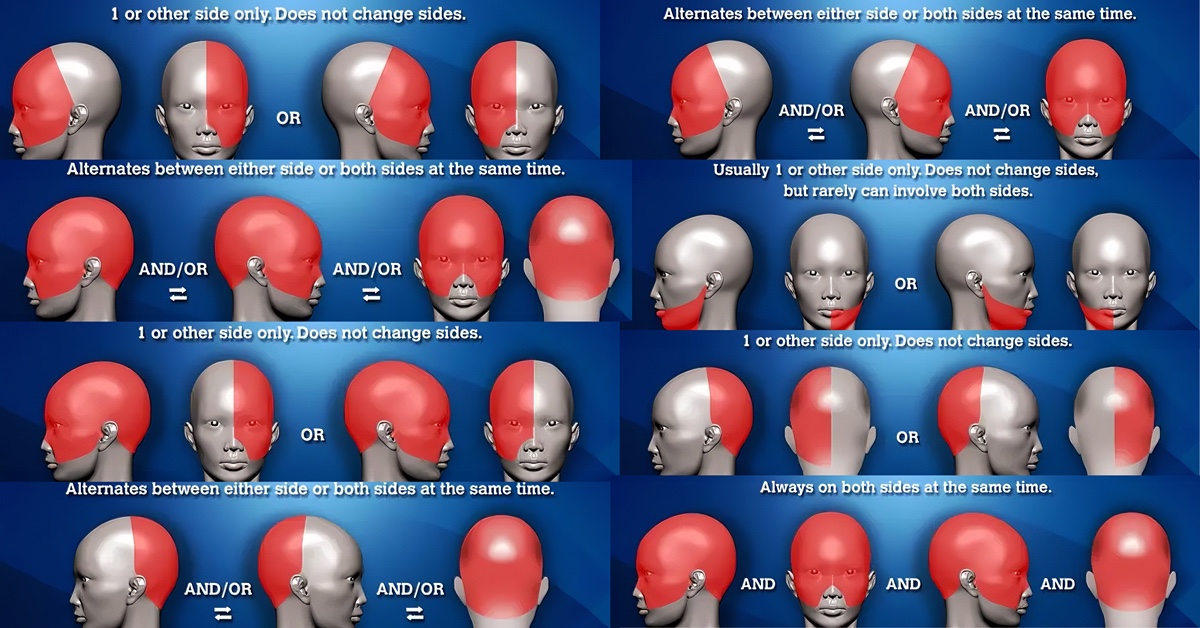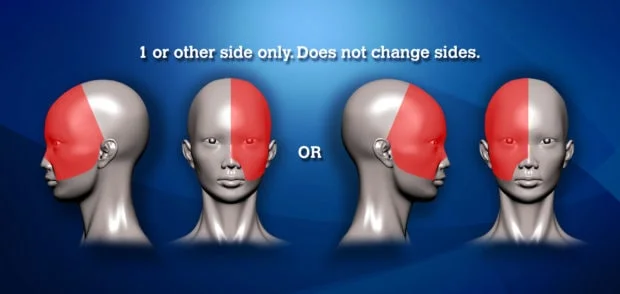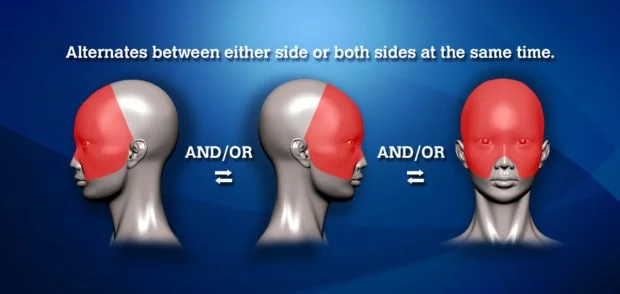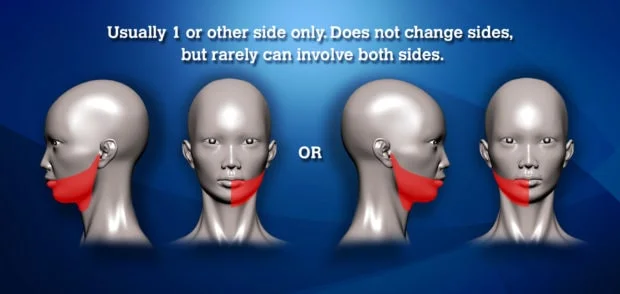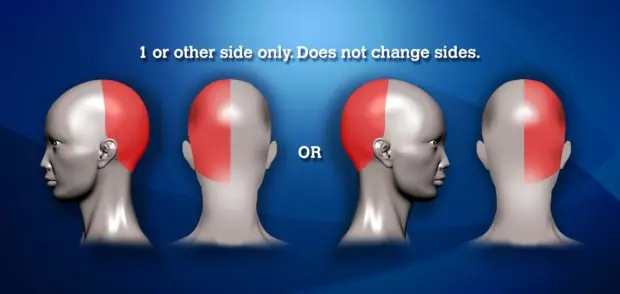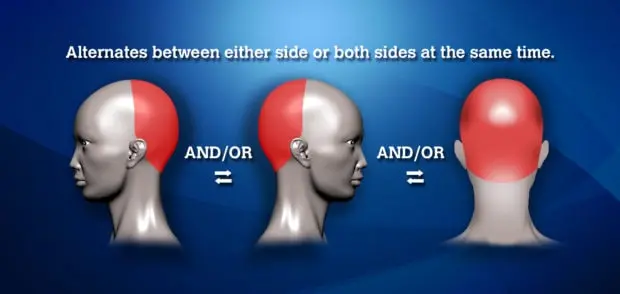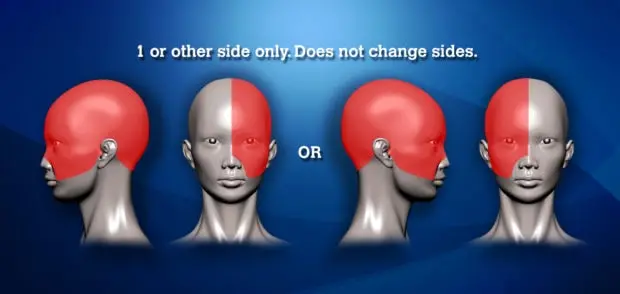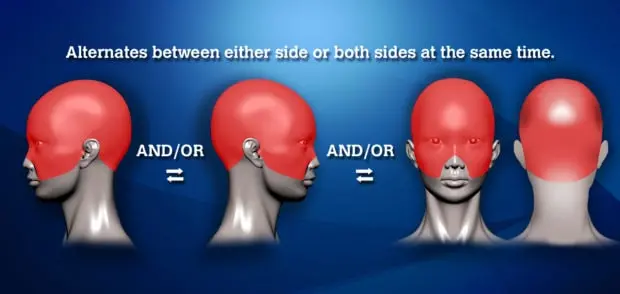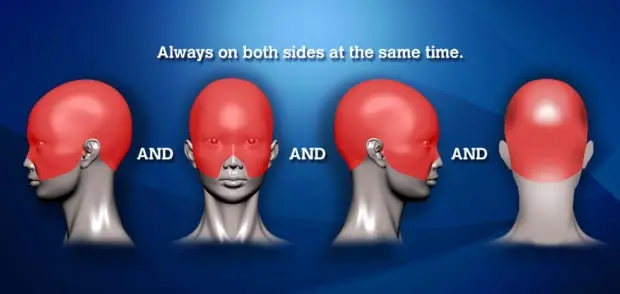Headache placement meanings and headache location meanings. These are common questions patients search for online (usually anxiously and sweating profusely). It is what they want to know when they see me as a headache specialist in the headache center. What kind of headache do they have based on location of the headache?
I’ve noticed that there are a ton of “headache charts”, “location of headache meaning”, “complete headache charts”, etc. floating around on the internet. As a headache specialist, I can tell you that they are pretty much all nonspecific, generic, and provide little to no value or direction, likely concocted by a non-headache specialist.
So, I felt it was my duty as an actual headache specialist to step up and provide a headache pain chart and facial pain chart that actually gives more accurate specific headache or face pain types to consider. Also, by the way, when you see headache types and headache pictures listed as “allergy headache” and “sinus headaches” to name just a couple I’ve seen floating around, my advice is to run from that site as fast as possible because the creator clearly isn’t a headache specialist.
This will be the most useful and the only headache chart you’ll ever need…
Location of your headache is a central piece of information in determining the different types of headaches that a patient might have. The headache chart, or headache map, is like a diagnostic map in that it can give direction to headache types based on location of your pain, but it doesn’t tell the whole story, nor can it give an accurate diagnosis.
Let me explain why…
There are many headache types that share the same locations but require different treatments. You may find a generic headache chart online showing pain on one side of the head around eye, temple, or forehead. It may list migraine or cluster headache as the cause. In reality, there are at least a dozen different types of headaches that could occur in the same location though.
So let me tell you a BIG secret…
Headaches are not diagnosed only by their location, but more importantly by the “company they keep”. In other words, the associated symptoms occurring with the headache are even more important than location alone.
The full diagnosis of a headache disorder is based on not only location, but location in combination with a number of other characteristics including frequency and duration of headache attacks, timing of attacks, description and characterization of the pain, associated neurological symptoms, and additional associated factors such as if there is nausea, sensitivity to light and sound, a red and tearing eye on one side, a runny nose or stuffy nose on the side of pain, droopiness of an eyelid, puffiness around the eye, hearing disturbances, and neurological symptoms such as vision disturbances, numbness and tingling, or speech disturbances, among other symptoms. Of course, an accurate diagnosis also requires an office visit with your doctor, a physical and neurological exam, and testing if they feel it is needed.
Without knowing all of this other crucial headache associated information, it is impossible to know a headache diagnosis based on location only, or on a headache chart alone. This is the most important point I would like you to keep in mind today.
Thus, I have created a FREE headache and facial pain symptom checker tool which incorporates not only location of headache, but also all of these important characteristics and associated symptoms into an algorithm. Think of these questions like a simulated office visit with a headache specialist, including all of these important questions they would ask.
This simulated visit will give you a fine-tuned more accurate list of possible headache or facial pain disorders to consider which you can discuss with your doctor. From that list, you will be directed to all of the education including the most common treatment plan such as prescription medication for that specific headache type for you and your doctor to discuss.
However, you are here today for the simple question of what headache types are possible based on your headache location, right? So, below you will see the most common primary headache and facial pain types that are based on location alone below each headache location illustration.
Keep in mind that all of these listed headache types cannot be accurately diagnosed unless you have the correct combination of patterns, characteristics, and associated features according to diagnostic criteria established by the International Headache Society, along with a discussion and physical examination by your doctor. Regardless, the headache maps below can provide a good conversation starting point about headache types to think about and discuss with your doctor. This is my goal here today with this blog, and why I created this FREE headache and facial pain symptom checker tool.
Lastly, it is important to know that the headache types listed below each headache picture only include primary headaches (such as migraine, cluster headaches, tension headaches, etc.). Primary headache disorders are usually benign headaches in contrast to secondary headaches, which are caused by some other concerning medical conditions such as brain tumor, brain aneurysm or problem with blood vessels, infection, trauma, etc. Secondary headaches require medical attention and sometimes emergent medical care (such as headache with a stiff neck with fever and confusion, thunderclap severe immediate onset headache, or severe headache during sexual intercourse as a few of many examples). These headache maps are not meant to identify any type of secondary headache or facial pain disorders.
A secondary headache caused by an underlying medical problem triggering the pain can also look like any primary headache disorder. Thus, any type of headache ALWAYS warrants an office visit with your doctor to fully discuss symptoms, do a neurological and medical exam, and order appropriate diagnostic tests such as brain scans, lumbar puncture, blood work, or other testing, depending on the headache story. Your doctor will be able to decide whether further testing is necessary based on all of this information obtained in an office visit.
With all of that said, have at it! Hope these headache pictures help to point you and your healthcare provider in the right direction!…
Location: Forehead, Cheek, Temporal Area (not variable)
-The headache is 100% always on 1 side of your head only.
-It never alternates between 1 side and the other side.
-It never involves both sides of the head at the same time.
Headache types to consider and discuss with your doctor:
Location: Forehead, Cheek, Temporal Area (variable)
-The headache varies in location.
-It may alternate between 1 side or the other side of the head at different times.
-It may commonly occur more often on 1 side or the other, however, it is not 100% always on the same side.
-It may sometimes involve both sides of the head at the same time as well.
Headache types to consider and discuss with your doctor:
Location: Chin
-Beneath the angle of the lower jaw, back of the throat or tonsils, back/base of the tongue, inside ear, or deep in the ear.
Facial pain types to consider and discuss with your doctor:
–Geniculate Neuralgia (Nervus Intermedius Neuralgia)
Location: Parietal-Occipital Area (not variable)
-The headache is 100% always on 1 side ONLY, focused in the back of your head.
-It NEVER alternates between 1 side and the other side.
-It NEVER involves both sides of the head at the same time.
Headache types to consider and discuss with your doctor:
Parietal-Occipital Area (variable)
-The headache is variable in location, focused in the back of your head.
-It may alternate between 1 side or the other side at different times.
-It may commonly occur more often on 1 side or the other. However, it is not 100% always on the same side.
-It may sometimes involve both sides of the head at the same time as well.
Headache types to consider and discuss with your doctor:
Location: Whole Side of Head (not variable) (Forehead, Cheek, Temporo-Parietal-Occipital Area)
-The headache is 100% always on 1 side only.
-It never alternates between 1 side and the other side.
-It never involves both sides of the head at the same time.
Headache types to consider and discuss with your doctor:
Location: Whole Side of Head (variable) (Forehead, Cheek, Temporo-Parietal-Occipital Area)
-The headache is variable in location.
-It may alternate between 1 side or the other side at different times.
-It may commonly occur more often on 1 side or the other. However, it is not always on the same side.
-It may sometimes involve both sides of your head at the same time as well.
Headache types to consider and discuss with your doctor:
Location: Whole Head (not variable) (Forehead, Cheek, Temporo-Parietal-Occipital Areas On Both Sides At the Same Time)
-The headache is never on 1 side only. It always involves the whole head on both sides at the same time.
Headache types to consider and discuss with your doctor:
The headache disorders listed under each headache picture above would be the top PRIMARY headache disorders to consider. However, there are other primary headache disorders listed below (as well as some secondary headache disorders) that could potentially manifest in any of these headache pain locations as well:
–New Daily Persistent Headache (NDPH)
–Medication Overuse Headache (Rebound Headache)
–Primary Headache Associated with Sexual Activity
The differentiations between the headache disorders listed above, as well as the headache types listed below each headache diagram are based on those specific associated headache symptoms and patterns, frequency of attacks, duration of attacks, pain character, additional features such as nausea, sensitivity to light and sound, droopy red or tearing eye, runny congested nose on one side, and other neurologic symptoms mentioned earlier. These important diagnostic variables are incorporated into this FREE headache and facial pain symptom checker tool if you want to fine tune the possibilities more.
Good luck! I hope this headache chart and headache and facial pain symptom checker tool lead you in a better direction of self-research. This should provide for more informative and efficient discussions with your doctor regarding possible headache types and more effective and appropriate treatment options to consider.
Ultimately, I hope that this information helps you get answers, a better quality of life, and less headache disruption of your function and life!
IF YOU HAVE HEADACHE, MIGRAINE, OR FACIAL PAIN AND ARE LOOKING FOR ANSWERS ON ANYTHING RELATED TO IT, A HEADACHE SPECIALIST IS HERE TO HELP, FOR FREE!
FIRST, LET’S DECIDE WHERE TO START:
IF YOU HAVE AN EXISTING HEADACHE, MIGRAINE, OR FACIAL PAIN DIAGNOSIS AND ARE LOOKING FOR THE LATEST INFORMATION, HOT TOPICS, AND TREATMENT TIPS, VISIT OUR FREE BLOG OF HOT TOPICS AND HEADACHE TIPS HERE. THIS IS WHERE I WRITE AND CONDENSE A BROAD VARIETY OF COMMON AND COMPLEX MIGRAINE AND HEADACHE RELATED TOPICS INTO THE IMPORTANT FACTS AND HIGHLIGHTS YOU NEED TO KNOW, ALONG WITH PROVIDING FIRST HAND CLINICAL EXPERIENCE FROM THE PERSPECTIVE OF A HEADACHE SPECIALIST.
IF YOU DON’T HAVE AN EXISTING HEADACHE, MIGRAINE, OR FACIAL PAIN DIAGNOSIS AND ARE LOOKING FOR POSSIBLE TYPES OF HEADACHES OR FACIAL PAINS BASED ON YOUR SYMPTOMS, USE THE FREE HEADACHE AND FACIAL PAIN SYMPTOM CHECKER TOOL DEVELOPED BY A HEADACHE SPECIALIST NEUROLOGIST HERE!
IF YOU HAVE AN EXISTING HEADACHE, MIGRAINE, OR FACIAL PAIN DIAGNOSIS AND ARE LOOKING FOR FURTHER EDUCATION AND SELF-RESEARCH ON YOUR DIAGNOSIS, VISIT OUR FREE EDUCATION CENTER HERE.

